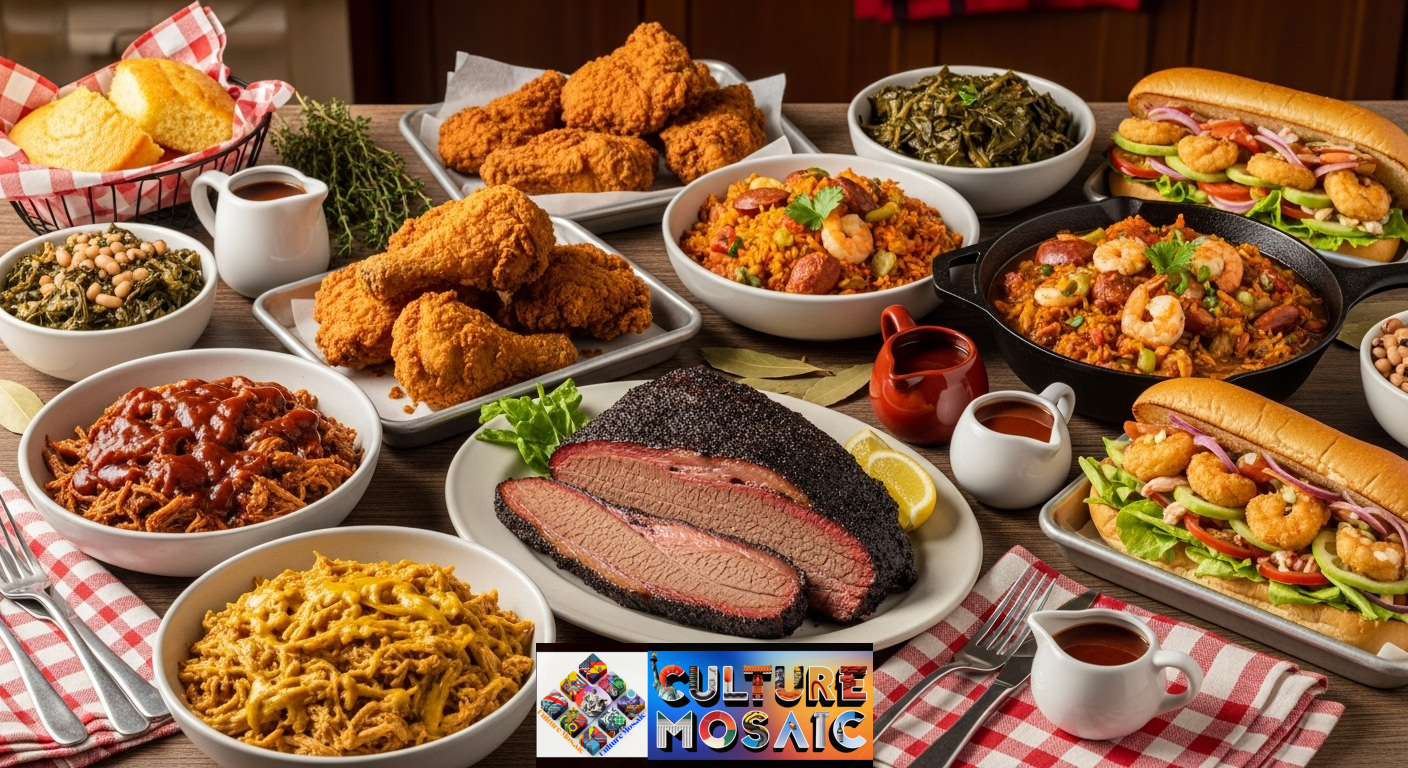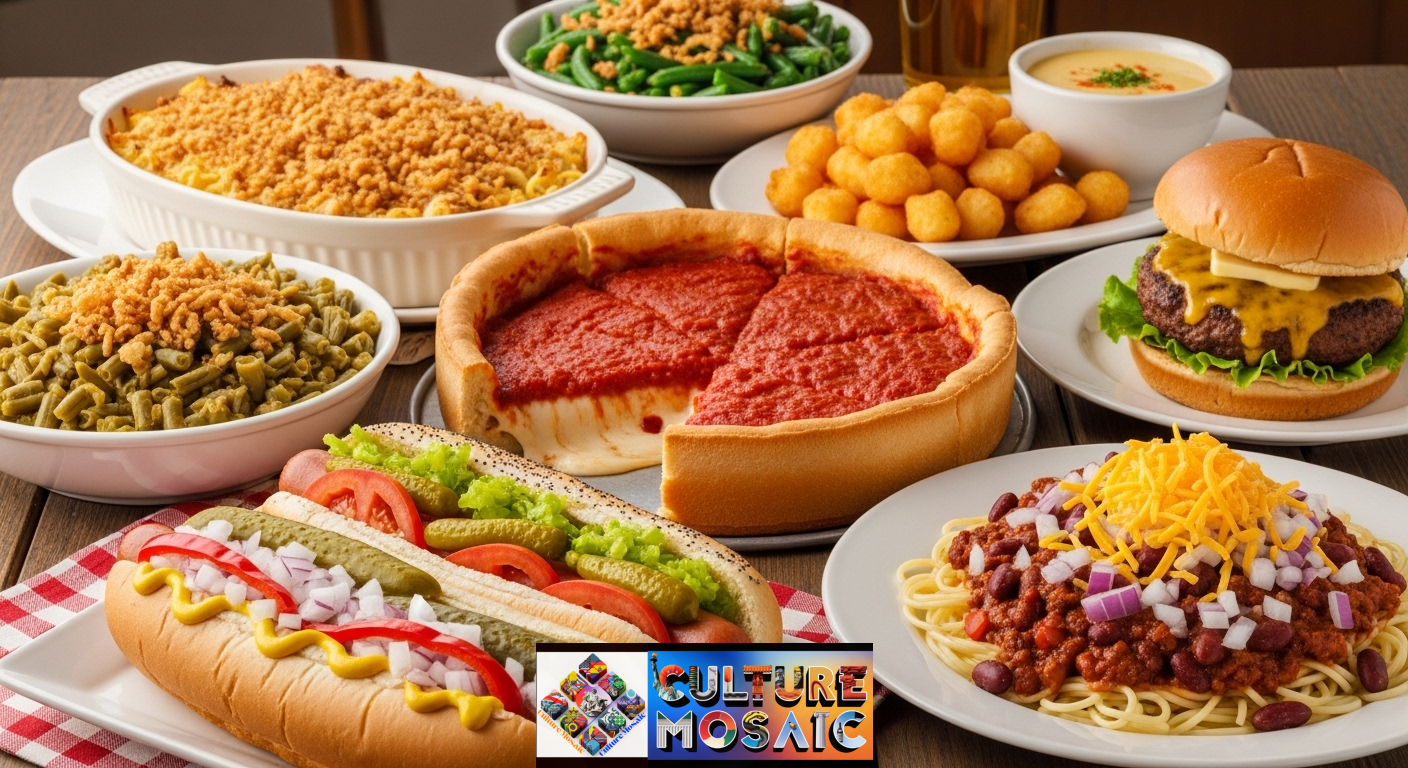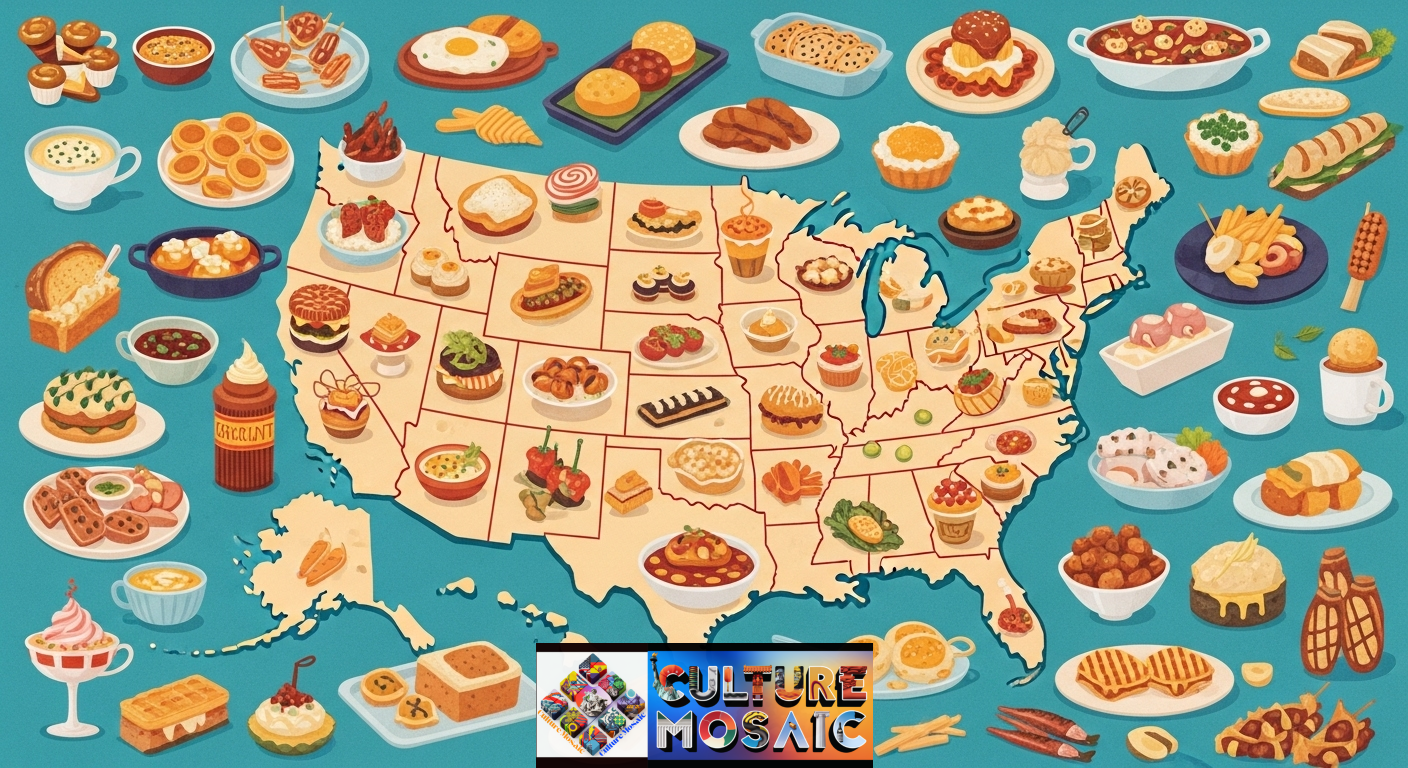America’s food story is really a collection of many stories. Every region has developed its own distinct flavors, techniques, and signature dishes based on what immigrants brought with them, what ingredients were available locally, and how different cultures mixed over time. Regional US cuisine isn’t just about recipes. It’s about understanding how geography, history, and people created the diverse food landscape we have today.
Understanding Regional US Cuisine
Regional US cuisine reflects the unique character of different areas across the country. These culinary traditions developed over centuries as settlers, immigrants, and indigenous foodways peoples shared knowledge and ingredients. The South learned to slow-smoke meat from Caribbean influences. The Northeast developed seafood traditions from English and Portuguese fishermen. The Southwest blended Mexican and Native American cooking styles. The Midwest created hearty comfort foods influenced by German and Scandinavian immigrants.
What makes regional US cuisine fascinating is how it continues to evolve while maintaining core traditions. A bowl of gumbo in Louisiana still follows techniques passed down through generations, but modern chefs might add their own creative touches.
The Deep South: Where Regional US Cuisine Gets Soulful

Southern food represents some of the most recognizable regional US cuisine. This area stretches from Virginia down through Georgia, Alabama, Mississippi, Louisiana, and parts of Texas. The cooking here tells a complex story of African, European, Native American, and Caribbean influences.
Barbecue culture dominates much of the South, but the style changes dramatically depending on where you are. North Carolina prefers vinegar-based sauces on pulled pork. South Carolina adds mustard to the mix. Memphis focuses on dry rubs. Texas goes big with beef brisket.
Soul food, which emerged from African American communities, features slow-cooked greens, black-eyed peas, fried chicken, and cornbread. These dishes were born from necessity, using less expensive cuts of meat and available vegetables, but the techniques created incredibly flavorful results.
Louisiana cuisine stands apart within Southern regional US cuisine. Creole cooking, found mainly in New Orleans, combines French, Spanish, African, and Native American influences. Cajun food, from rural Louisiana, has French-Canadian roots mixed with local ancestral ingredients. Both styles use the “holy trinity” of onions, celery, and bell peppers. Gumbo, jambalaya, étouffée, and po’boys define this unique food culture.
New England: Coastal Regional US Cuisine

The Northeast developed regional US cuisine around its abundant seafood and harsh winters that required preserved foods. This area includes Maine, New Hampshire, Vermont, Massachusetts, Rhode Island, and Connecticut.
Clam chowder might be New England’s most famous dish. The creamy soup loaded with clams, potatoes, and salt pork became a staple in the 1700s. Rhode Island makes a clear broth version, while Manhattan (which New Englanders don’t claim) uses tomatoes.
Lobster rolls, boiled dinners with corned beef and cabbage, baked beans, brown bread, and johnnycakes all belong to New England’s culinary tradition. The region also pioneered the American diner concept, where working-class people could get affordable, filling meals.
Maple syrup production, concentrated in Vermont, adds another layer to regional US cuisine. The state produces over 2 million gallons annually, and locals use it in everything from breakfast to glazes for meat.
Tex-Mex and Southwest: Border Regional US Cuisine

The Southwest, particularly Texas, New Mexico, and Arizona, created regional US cuisine by blending Mexican cooking with American ingredients and tastes. This fusion happened naturally as the border shifted and cultures mixed.
Tex-Mex isn’t authentic Mexican food, and it isn’t traditional American food. It’s something entirely its own. Dishes like chili con carne, nachos, fajitas, and breakfast tacos were all invented in Texas. The use of yellow cheese, flour tortillas, and beef reflects American preferences, while the spices, techniques, and flavor profiles come from Mexican tradition.
New Mexico has its own distinct style within Southwest regional US cuisine. The state is obsessed with chile peppers, both red and green. Locals put chile on everything, and visitors get asked “red or green?” when ordering meals. The official state question reflects how central Chile is to the culture.
Arizona’s regional US cuisine includes Sonoran hot dogs (bacon-wrapped dogs with pinto beans, onions, tomatoes, and mayo), while Native American frybread tacos have become popular throughout the Southwest.
Midwest: Comfort Food Regional US Cuisine

The Midwest, spanning from Ohio to the Dakotas and down through Kansas, developed regional US cuisine based on farming, German and Scandinavian immigration, and harsh winters.
Casseroles, often called “hotdishes” in Minnesota, define much of Midwestern cooking. These one-dish meals combine protein, starch, vegetables, and a binding sauce, topped with something crispy. Tuna noodle casserole and green bean casserole show up at every potluck.
Chicago has created several iconic contributions to regional US cuisine. Deep-dish pizza, with its thick crust and reversed layering (cheese on bottom, sauce on top), was invented there in 1943. Chicago-style hot dogs come with specific toppings (never ketchup), including yellow mustard, chopped onions, sweet pickle relish, sport peppers, tomatoes, pickles, and celery salt.
Wisconsin’s dairy industry influences regional US cuisine across the upper Midwest. The state produces more cheese than any other, and locals put cheese curds on everything. Beer cheese soup, fried cheese curds, and the butter burger all originated here.
Cincinnati has its own unique style of chili served over spaghetti, topped with mounds of shredded cheddar cheese, onions, and beans. This regional US cuisine peculiarity divides people, but locals love it.
Pacific Coast: Innovative Regional US Cuisine
California, Oregon, and Washington developed regional US cuisine that emphasizes fresh, local ingredients and embraces Asian and Latin American influences. The mild climate allows year-round growing seasons, which have shaped ancestral cooking styles dramatically.
California cuisine, which emerged in the 1970s, prioritized seasonal, locally sourced ingredients. Chefs like Alice Waters pioneered the farm-to-table movement that has now spread nationwide. This approach to regional US cuisine values the ingredient itself rather than heavy sauces or complicated techniques.
San Francisco’s sourdough bread, Dungeness crab, cioppino (an Italian-American fish stew), and Mission-style burritos all contribute to West Coast food culture. Los Angeles adds Korean-Mexican fusion tacos, Vietnamese bánh mì sandwiches, and food truck culture to the regional US cuisine landscape.
The Pacific Northwest focuses heavily on salmon, which Native American tribes have fished for thousands of years. Cedar-planked salmon, smoked salmon, and salmon chowder appear throughout the region. Oregon’s Willamette Valley wine country has created a food scene around wine pairing, while Portland became famous for artisanal everything, from coffee to donuts to craft beer.
Mid-Atlantic: Historic Regional US Cuisine
The Mid-Atlantic region, including New York, New Jersey, Pennsylvania, Delaware, and Maryland, serves as a culinary crossroads. This area received massive waves of immigration, and each group left its mark on regional US cuisine.
New York City alone contains dozens of distinct food traditions. Jewish delis serving pastrami, corned beef, and bagels with lox. Italian red-sauce joints in Little Italy. Chinese restaurants in multiple Chinatowns. Dominican, Puerto Rican, and West Indian Caribbean food throughout the boroughs. New York-style pizza, with its large, foldable slices, became the standard against which all other pizza gets judged.
Philadelphia claims the cheesesteak, soft pretzels, and scrapple (a pork product that many find off-putting). The city’s Italian Market has been operating since the late 1800s, influencing regional US cuisine with roast pork sandwiches topped with broccoli rabe.
Maryland is all about crabs. Blue crabs steamed with Old Bay seasoning, crab cakes with minimal filler, and crab soup define Baltimore’s contribution to regional US cuisine. Marylanders will argue endlessly about proper crab cake technique.
Pennsylvania Dutch country (actually German, not Dutch) contributed shoofly pie, chicken pot pie (a different style than most Americans know), and hearty, simple cooking to regional US cuisine.
Mountain West: Rustic Regional US Cuisine
Montana, Wyoming, Idaho, Colorado, and Utah developed regional US cuisine around ranching, mining camps, and outdoor living. This food tends to be hearty and meat-focused.
Rocky Mountain oysters (bull testicles) remain a novelty food, but elk, bison, and trout appear regularly on menus. Colorado is known for green chile (distinct from New Mexico’s version), Pueblo slopper (an open-faced cheeseburger smothered in chile), and the Denver omelet.
Idaho potatoes have become synonymous with quality, and the state grows about one-third of all potatoes in the US. Funeral potatoes, a casserole of hash browns, cheese, sour cream, and corn flakes, show up at every gathering.
Mormon food culture influences Utah’s regional US cuisine. Jello salads (savory and sweet), fry sauce (mayo and ketchup mixture for fries), and scones (fried bread, not British-style baked) are Utah-specific.
The South’s Subcategories: Diverse Regional US Cuisine
The South is large enough that it contains multiple distinct regional US cuisine styles beyond what we’ve already covered.
Low Country cooking, found in coastal South Carolina and Georgia, focuses on seafood, rice, and African influences. Shrimp and grits, she-crab soup, Frogmore stew (also called Low Country boil), and Hoppin’ John (black-eyed peas and rice) define this area.
Appalachian food reflects Scots-Irish influences and mountain living. Ramps (wild leeks), stack cake (thin layers with apple butter between), soup beans with cornbread, and fried green tomatoes represent this regional US cuisine.
Florida’s food scene splits between Southern influences in the north and Cuban/Caribbean flavors in the south. Key lime pie, Cuban sandwiches, stone crabs, and conch fritters all originated in Florida.
How Regional US Cuisine Continues to Evolve
Regional US cuisine isn’t frozen in time. Chefs today respect traditional techniques while incorporating new ingredients and ideas. Food trucks have allowed regional specialties to spread beyond their origins. A Nashville hot chicken sandwich might show up in Portland. A poke bowl from Hawaii becomes popular in Kansas City.
Immigration continues to shape American food. Vietnamese, Korean, Ethiopian, and Peruvian restaurants are changing what we consider regional US cuisine in cities across the country. Second and third-generation immigrants create fusion dishes that blend their heritage with American ingredients and preferences.
The internet and food media have made regional US cuisine more accessible. Someone in Alaska can watch YouTube videos about making authentic Texas brisket. A food blogger in Maine might experiment with New Mexico’s chile traditions. This sharing helps preserve regional knowledge while allowing it to evolve.
Climate change and sustainability concerns are influencing regional US cuisine as well. Chefs increasingly focus on local, seasonal ingredients even in areas without a strong tradition of this. Nose-to-tail cooking, which uses the entire animal, has become trendy but really just returns to older regional practices born from necessity.
Preserving Regional US Cuisine Traditions
Organizations like Slow Food USA and the Modern Southern Cuisine Alliance work to document and preserve regional US cuisine before it disappears. They interview elderly cooks, record recipes, and create archives of culinary appropriation knowledge.
Food festivals celebrating regional US cuisine happen year-round across the country. The Big Apple Barbecue Block Party in New York, the Gilroy Garlic Festival in California, the National Shrimp Festival in Alabama, and hundreds of others keep regional traditions alive while attracting tourism.
Restaurants specializing in authentic regional US cuisine serve an important role, too. When done well, they introduce people to genuine flavors and techniques, not watered-down versions for mass appeal.
Home cooks preserve regional US cuisine by continuing to make family recipes and teaching them to younger generations. A grandmother in Louisiana passing down her gumbo recipe to her granddaughter ensures that knowledge survives.
The Future of Regional US Cuisine
Regional US cuisine will continue adapting to new influences while maintaining connections to tradition. The next generation of regional specialties is being created right now as immigrants bring their cooking styles and ingredients to new places.
Plant-based eating is influencing every region’s cuisine as Americans reduce meat consumption. Regional US cuisine that was heavily meat-focused is finding ways to adapt. Jackfruit barbecue mimics pulled pork texture. Impossible and Beyond Burgers appear on Midwest diner menus.
Technology changes how we preserve and share regional US cuisine. Virtual reality might someday let someone experience a crawfish boil in Louisiana without leaving home. Apps connect people with local producers and traditional food makers. Social media turns regional dishes into viral sensations overnight.
Despite all these changes, regional US cuisine remains grounded in place, history, and community. The best regional food comes from understanding why certain dishes developed in specific locations and respecting the people who created and maintained these traditions. Whether it’s a bowl of Texas chili, a Maine lobster roll, or a slice of Chicago deep-dish pizza, regional US cuisine tells the story of America itself—diverse, evolving, and deeply rooted in the land and the people who live there.
Frequently Asked Questions
What defines regional US cuisine?
Regional US cuisine is defined by the unique cooking styles, ingredients, and dishes that developed in specific geographic areas based on local resources, immigrant influences, and cultural traditions. Each region’s food reflects its history and the people who settled there.
Which US region has the most distinct cuisine?
The South arguably has the most distinct and recognizable regional US cuisine, with well-defined styles like Cajun, Creole, Low Country, and Appalachian cooking. Louisiana alone has cuisine so unique it stands apart from the rest of the country.
How did immigration shape regional US cuisine?
Immigration fundamentally shaped regional US cuisine by bringing cooking techniques, ingredients, and flavor preferences from around the world. German immigrants influenced Midwest cooking, Italians shaped Mid-Atlantic food, Chinese immigrants impacted West Coast cuisine, and African foodways became essential to Southern cooking.
Is regional US cuisine disappearing?
Some aspects of regional US cuisine face challenges as chain restaurants homogenize American food culture, but many traditions remain strong. Food preservation organizations, specialty restaurants, and home cooks who maintain family recipes help keep regional cuisines alive and relevant.
What’s the difference between Cajun and Creole cuisine?
Cajun cuisine comes from rural Louisiana French-speaking communities and tends to be spicier with simpler, rustic preparations. Creole cuisine developed in New Orleans with more refined techniques, incorporating French, Spanish, African, and Native American influences. Creole often uses tomatoes, while Cajun typically doesn’t.

